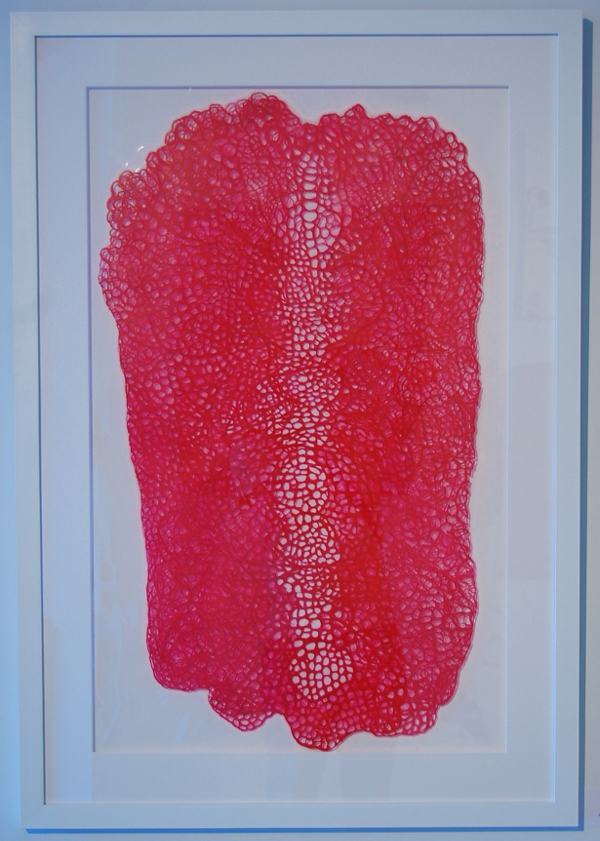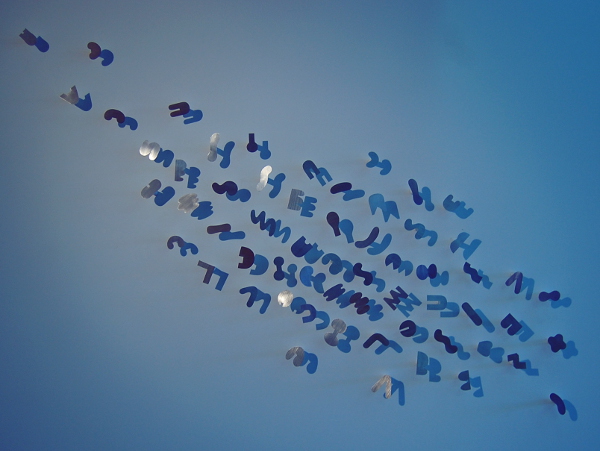
Esther Klein Gallery’s “Cellular/Molecular” alongside Philadelphia Science Festival
Breadboard‘s Esther Klein Gallery (EKG) in University City is thinking big by getting small. The worlds of the microscopic are the subject of the show “Cellular/Molecular,” curated by Gaby Heit, which just opened to the public on April 16. This exhibit also coincides with the 3d annual Philadelphia Science Festival, which takes places from April 18-28 all around the city.
Images and forms that were practically unknown to humans hardly a century or two ago comprise the bulk of the artwork hanging at EKG. In many ways, this art is a testament to the power and tenacity of the human mind, cooperation and the scientific method. Without the search for knowledge over many generations, it is even possible that such a show may never have existed in the first place.
Bruce Pollock includes a pair of oil paintings which emphasize structure on a grand scale. His piece “Red Square” is exactly what the name implies, except that the square merely represents the edge of the canvas. The tiny circular patterns which spin across the surface could feasibly extend on forever, but here exist as a lone square snippet of infinity. As opposed to the two-dimensional spread in “Red Square”, Pollock’s “Pearl Net” is composed of iridescent lines that form a meshed construction. Here the lattice presents an illusion of depth, extending into the distance like a self-repeating fractal. Just as molecules connect to form objects visible at the human level, this painting could very well be a closeup of carbon atom buckyball formations or many other chemical compounds. It is a reminder that even the most mundane of substances is still a complex network of pieces as small and extensive as a galaxy is massive.
Alice Whealin, “Skin.”
Just across the way, Alice Whealin’s piece “Skin” seems to mirror Pollock’s sentiments in hues of deep red. Whealin uses ink on acetate to produce tapestry-like objects that look more knitted than drawn. The interwoven paths of her pigments overlap and allow varying amounts of the white backing to peer through and produce a sharp contrast and sense of space. If anything, this sliver of acetate betrays its plastic-like nature by way of the applied ink, and resembles a crocheted blanket more than anything (although likely a slippery one, at that).
Angela McQuillan, “Circumvolution.”
It’s a busy place in Angela McQuillan’s paintings, at least if you’re a paramecium. Countering the chemicals in the aforementioned work, McQuillian wanders into more biological pastures. The artist’s pastel colors slip and slide like cell walls and cilia; there is no shortage of action in her renderings, even if the single-celled characters don’t have quite the charisma of actors on the silver screen. This is not to say that they don’t have a personality, though. A teal-colored amoeba seems to be stretching its arm (read: pseudopod) and reaching toward some other blue blob in “Circumvolution.” It actually feels difficult not to root for the little guy, even if his ultimate goal is a mystery. The dripping branches and sweeping tendrils nearby appear as obstacles to our protagonist and seem more like the setting than members of the cast.
Dolores Paocelli, “Singularities.”
Dolores Paocelli’s “Singularities” is a welcome change from much of the work by providing an actual three-dimensional installation. While it is still wall-mounted, the pieces of shiny, recycled aluminum crawl up the surface as if headed for some distant receptor in someone’s oversized brain. The cutouts are of many different shapes, none of which seem to repeat, although their shadows make it difficult to determine, as they effectively double everything in view.
There is plenty of time to see “Cellular/Molecular”, as it will be on display not only through the Philadelphia Science Festival, but all the way until June 9. There will be an opening reception at EKG on Thursday, April 25 from 5-8 p.m. Otherwise EKG is open to the public Monday – Saturday, 10 a.m.-5 p.m.
The Esther Klein Gallery is located at 3600 Market Street in the lobby of the Science Center, Philadelphia; [email protected]; kleinartgallery.org.
Recent Content
-
Artsarticle ·
-
Artsarticle ·
-
Artsarticle ·



